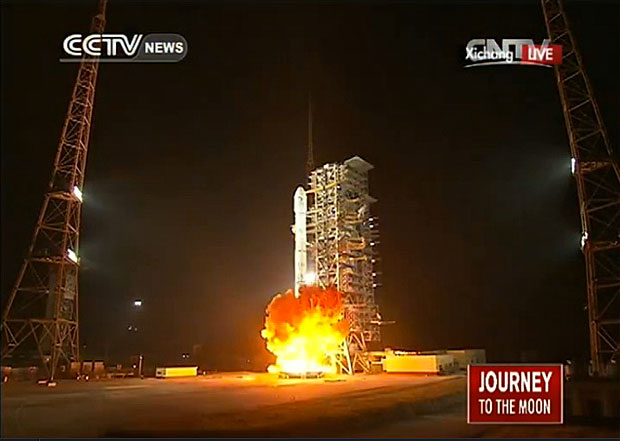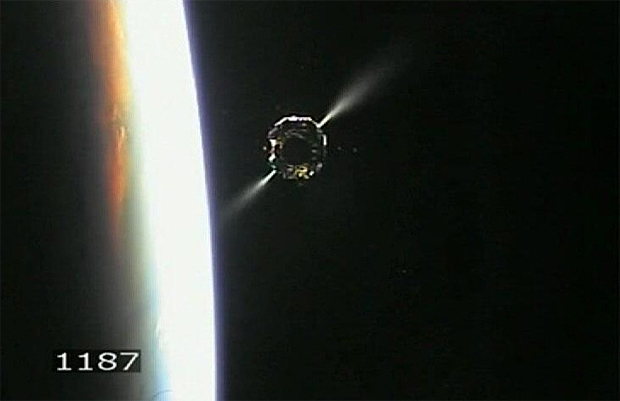China launches Chang'e-3 lunar lander
By WILLIAM HARWOOD
CBS News
A powerful Long March 3B rocket boosted China's first lunar lander into space Sunday, an unmanned mothership that will descend to the surface in mid December and deploy a rover named Yutu, or "Jade Rabbit," for independent scientific observations.
Following a step-by-step approach that builds on lessons learned from earlier missions, the Chang'e-3 spacecraft follows two earlier Chinese lunar orbiters that helped engineers perfect the technology needed for more ambitious missions while mapping the moon's surface and collecting the data needed to identify favorable landing sites.
Chang'e-3, named after a mythical Chinese goddess in a national poll, represents China's first attempt to land on another extraterrestrial body and the first moon lander since the former Soviet Union's Luna 24 sample return mission in 1976.
The launching was carried live on Chinese television and right on time, at 12:30 p.m. EST (GMT-5; 1:30 a.m. Monday local time), the 183-foot-tall Long March roared to life and vaulted away from its pad at the Xichang Satellite Launch Center, lighting up the sky with a rush of flame from four strap-on boosters.
The climb to space appeared to go smoothly and after a brief coast in a so-called parking orbit, the Long March 3B's third stage engine re-ignited to boost the Chang'e-3 spacecraft onto the planned trajectory to the moon.
A few moments later, live television shots from a camera mounted on the booster's third stage showed the moon probe moving away on its own, followed by an on-board rocket firing. About 50 minutes after liftoff, the spacecraft's solar arrays deployed to successfully complete the launch phase.
Zhang Zhenzhong, director of the Chinese space center, declared the launching "a complete success."
"On behalf the Xichang Satellite Launch Center ... I would like to extend my gratitude to all those who have been part of this project," he said in translated remarks broadcast live on CCTV.
He said the Chang'e-3 probe "is a symbol of China's national power and prowess," and urged his colleagues to "work together ... to make more effort in space exploration and realize Chinese dream."
According to Chinese news accounts, the flight plan for Chang'e-3 called for a five-day voyage to the moon before braking into an initial 62-mile-high orbit. Four days after arriving, the spacecraft will move into an elliptical orbit and four days after that, it will descend to an altitude of just 9.3 miles above the lunar surface.
From there, the Chang'e-3 spacecraft will descend to the surface using a variable-thrust engine, sophisticated sensors and a flight computer capable of detecting and avoiding obstacles.
The lander is equipped with a radioisotope thermoelectric generator, using the heat produced by the decay of radioactive plutonium 238 to generate electricity. Such nuclear generators have been used in a variety of U.S. and Russian spacecraft, but this is the first use of an RTG aboard a Chinese space probe.
The nuclear generator will be used to keep the lander's systems warm during the cold lunar nights while the spacecraft's solar panels provide additional power during daylight.
Once safely on the moon, Chang'e-3 will deploy two articulating ramps needed by the rover, mounted atop the lander, to get down to the ground.
The 265-pound Yutu rover, named after the pet rabbit of the goddess Chang'e, is a solar-powered six-wheeled mobile research station reminiscent of NASA's Mars rovers. The Chinese rover is equipped with a variety of instruments, including a ground-penetrating radar to study the lunar soil and sub-surface geology along its path.
CBS News
A powerful Long March 3B rocket boosted China's first lunar lander into space Sunday, an unmanned mothership that will descend to the surface in mid December and deploy a rover named Yutu, or "Jade Rabbit," for independent scientific observations.
Following a step-by-step approach that builds on lessons learned from earlier missions, the Chang'e-3 spacecraft follows two earlier Chinese lunar orbiters that helped engineers perfect the technology needed for more ambitious missions while mapping the moon's surface and collecting the data needed to identify favorable landing sites.
 |
| A Long March 3B rocket thunders to life, boosting China's first lunar lander into space for a five-day flight to the moon. (Credit: CCTV) |
Chang'e-3, named after a mythical Chinese goddess in a national poll, represents China's first attempt to land on another extraterrestrial body and the first moon lander since the former Soviet Union's Luna 24 sample return mission in 1976.
The launching was carried live on Chinese television and right on time, at 12:30 p.m. EST (GMT-5; 1:30 a.m. Monday local time), the 183-foot-tall Long March roared to life and vaulted away from its pad at the Xichang Satellite Launch Center, lighting up the sky with a rush of flame from four strap-on boosters.
The climb to space appeared to go smoothly and after a brief coast in a so-called parking orbit, the Long March 3B's third stage engine re-ignited to boost the Chang'e-3 spacecraft onto the planned trajectory to the moon.
A few moments later, live television shots from a camera mounted on the booster's third stage showed the moon probe moving away on its own, followed by an on-board rocket firing. About 50 minutes after liftoff, the spacecraft's solar arrays deployed to successfully complete the launch phase.
Zhang Zhenzhong, director of the Chinese space center, declared the launching "a complete success."
"On behalf the Xichang Satellite Launch Center ... I would like to extend my gratitude to all those who have been part of this project," he said in translated remarks broadcast live on CCTV.
He said the Chang'e-3 probe "is a symbol of China's national power and prowess," and urged his colleagues to "work together ... to make more effort in space exploration and realize Chinese dream."
 |
| The Chang'e-3 moon probe flies on its own after separation from the third stage of a Long March 3B rocket, firing on-board thrusters for attitude control in this view from a camera mounted on the booster. If all goes well, the lander will descend to the moon's surface later this month and deploy a small rover. (Credit: CCTV) |
According to Chinese news accounts, the flight plan for Chang'e-3 called for a five-day voyage to the moon before braking into an initial 62-mile-high orbit. Four days after arriving, the spacecraft will move into an elliptical orbit and four days after that, it will descend to an altitude of just 9.3 miles above the lunar surface.
From there, the Chang'e-3 spacecraft will descend to the surface using a variable-thrust engine, sophisticated sensors and a flight computer capable of detecting and avoiding obstacles.
The lander is equipped with a radioisotope thermoelectric generator, using the heat produced by the decay of radioactive plutonium 238 to generate electricity. Such nuclear generators have been used in a variety of U.S. and Russian spacecraft, but this is the first use of an RTG aboard a Chinese space probe.
The nuclear generator will be used to keep the lander's systems warm during the cold lunar nights while the spacecraft's solar panels provide additional power during daylight.
Once safely on the moon, Chang'e-3 will deploy two articulating ramps needed by the rover, mounted atop the lander, to get down to the ground.
The 265-pound Yutu rover, named after the pet rabbit of the goddess Chang'e, is a solar-powered six-wheeled mobile research station reminiscent of NASA's Mars rovers. The Chinese rover is equipped with a variety of instruments, including a ground-penetrating radar to study the lunar soil and sub-surface geology along its path.